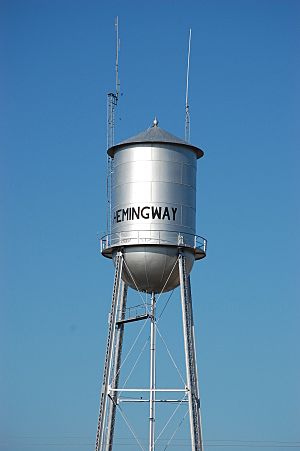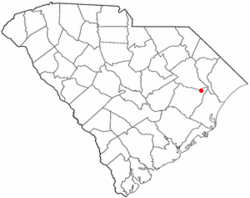Hemingway, South Carolina facts for kids
Quick facts for kids
Hemingway, South Carolina
|
|
|---|---|

Water tower in downtown Hemingway
|
|

Location of Hemingway, South Carolina
|
|
| Country | United States |
| State | South Carolina |
| County | Williamsburg |
| Area | |
| • Total | 0.86 sq mi (2.24 km2) |
| • Land | 0.86 sq mi (2.24 km2) |
| • Water | 0.00 sq mi (0.00 km2) |
| Elevation | 52 ft (16 m) |
| Population
(2020)
|
|
| • Total | 504 |
| • Density | 583.33/sq mi (225.28/km2) |
| Time zone | UTC-5 (Eastern (EST)) |
| • Summer (DST) | UTC-4 (EDT) |
| ZIP code |
29554
|
| Area code(s) | 843, 854 |
| FIPS code | 45-33145 |
| GNIS feature ID | 1245951 |
Hemingway is a small town located in Williamsburg County, South Carolina, in the United States. In 2020, about 504 people lived there.
Contents
Discovering Hemingway's Past
Hemingway started as a small community called Lamberts in 1911. Dr. W. C. Hemingway helped create the town. He wanted to make sure a new railroad line would have a stop there. This railroad, the Seaboard Coast Line Railroad, was planned to run from Mullins to Andrews.
Dr. Hemingway had his land surveyed and sold off lots. Soon after, the railroad built a station in Hemingway. The local post office then changed its name to Hemingway.
Growth of a Market Town
With the railroad, Hemingway grew into a busy market town. Farmers brought their crops here to sell. At first, cotton was a main crop. But after 1921, tiny insects called boll weevils damaged the cotton plants. Farmers then started growing more tobacco.
Other important products from the area included wood from pine forests. Farmers also grew corn, soybeans, wheat, and different vegetables.
Local Landmarks and History
Hemingway is close to the Pee Dee River. This river was once the main way to transport goods before the railroad arrived. A nearby place called Snows Lake is also important. It was a camp for General Francis Marion, a hero from the Revolutionary War. The Pee Dee River was named after the Pee Dee Native American tribe. The Waccamaw River, another large river, was also named after a tribe.
The Pleasant Hill Consolidated School is a historic building in Hemingway. It was added to the National Register of Historic Places in 1998.
Hemingway's Location and Size
Hemingway is located in South Carolina. The town covers an area of about 0.9 square miles (2.3 km2). All of this area is land, with no large bodies of water inside the town limits.
People Living in Hemingway
| Historical population | |||
|---|---|---|---|
| Census | Pop. | %± | |
| 1920 | 371 | — | |
| 1930 | 351 | −5.4% | |
| 1940 | 536 | 52.7% | |
| 1950 | 821 | 53.2% | |
| 1960 | 951 | 15.8% | |
| 1970 | 1,026 | 7.9% | |
| 1980 | 853 | −16.9% | |
| 1990 | 829 | −2.8% | |
| 2000 | 573 | −30.9% | |
| 2010 | 459 | −19.9% | |
| 2020 | 504 | 9.8% | |
| U.S. Decennial Census | |||
In 2000, there were 573 people living in Hemingway. These people lived in 259 households. About 26% of households had children under 18. The average age of people in the town was 45 years old.
Hemingway's Economy and Jobs
For a long time, farming was very important in Hemingway. Making clothes and other fabrics was also a big industry. Many sewing factories used to be here, but most have closed.
Current Industries
Some factories are still open today. Talous makes special suits that protect against insects. Hemingway Apparel also makes clothing. Other important businesses include:
- Tupperware, which makes plastic kitchen products.
- House of Raeford, which produces meat products.
- C-V Unlimited, which rebuilds auto parts.
- Don's Scrap Iron and Metal Co.
- Southeastern Wire Fabricators, Inc., which makes wire products.
- Palmetto Paper Tube.
Some people from Hemingway travel to work in other towns. They might go to Wellman Industries in Johnsonville, South Carolina. Others work at International Paper Company or Georgetown Steel in Georgetown. Williamsburg County also has a bus service. This helps workers get to jobs in the hospitality and construction industries in nearby Myrtle Beach.
Recent Changes in Industry
In June 2024, Tupperware announced it would close its factory in Hemingway. This meant almost 150 people would lose their jobs. The factory first opened in 1976. There had been other job cuts in 1996 and 2005.
Hemingway and Johnsonville
Hemingway has always been closely connected to Johnsonville. Even though a county line separates them, Johnsonville is only about 4 miles (6.4 km) north. People sometimes call them the "twin cities." Hemingway recently built a new industrial park between the two towns. It has good water and sewer services for new businesses.
Arts and Fun in Hemingway
Hemingway hosts a special event every spring. It's called the Bar-B-Q Shag Festival. This festival has a cooking contest for pork barbecue. It also features dancing of the Carolina shag, which is the official state dance of South Carolina.
The town also has a public library. It is a part of the Williamsburg County Library system.
Famous People from Hemingway
- Rodney Scott: He is a famous barbecue chef. He won a James Beard Foundation Award. He owns Rodney Scott's Whole Hog BBQ and Scott's Barbeque, which is in Hemingway.
- Sylvia Woods: She was an American restaurant owner. She helped start Sylvia's Restaurant of Harlem.
See also
 In Spanish: Hemingway (Carolina del Sur) para niños
In Spanish: Hemingway (Carolina del Sur) para niños

